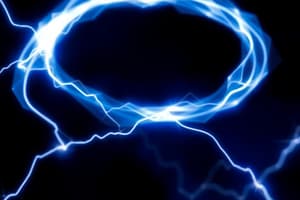Podcast
Questions and Answers
What is the SI unit of electric charge?
What is the SI unit of electric charge?
- Ampere
- Volt
- Coulomb (correct)
- Ohm
According to Coulomb's Law, the electric force between two charges decreases when which of the following happens?
According to Coulomb's Law, the electric force between two charges decreases when which of the following happens?
- The charges increase
- The product of the charges increases
- The distance increases (correct)
- The distance decreases
What happens to like charges?
What happens to like charges?
- They repel each other (correct)
- They combine to form a neutral charge
- They have no effect on each other
- They attract each other
Which equation correctly represents the calculation of electric field strength?
Which equation correctly represents the calculation of electric field strength?
What is electric potential also referred to as?
What is electric potential also referred to as?
What occurs during electrostatic induction?
What occurs during electrostatic induction?
In Coulomb's Law, the constant 'k' represents what?
In Coulomb's Law, the constant 'k' represents what?
Which of the following correctly describes an electric field?
Which of the following correctly describes an electric field?
The equation for electric potential can be expressed as which of the following?
The equation for electric potential can be expressed as which of the following?
If two opposite charges are brought close together, what will happen to the forces between them?
If two opposite charges are brought close together, what will happen to the forces between them?
Flashcards are hidden until you start studying
Study Notes
Electrostatics
Definition
Electrostatics is the branch of physics that deals with the study of static electric charges, their properties, and their interactions.
Electric Charge
- Electric charge is a fundamental property of matter that can be positive or negative.
- Like charges repel each other, while opposite charges attract each other.
- The SI unit of electric charge is the coulomb (C).
Coulomb's Law
- Coulomb's Law states that the electric force between two point charges is proportional to the product of the charges and inversely proportional to the square of the distance between them.
- Mathematically, it can be expressed as:
F = k * (q1 * q2) / r^2
where F is the electric force, k is Coulomb's constant, q1 and q2 are the charges, and r is the distance between them.
Electric Field
- An electric field is a region around a charged particle where the force of the charge can be detected.
- It can be represented by lines that emerge from positive charges and enter negative charges.
- The strength of the electric field can be calculated using the equation:
E = F / q
where E is the electric field strength, F is the force, and q is the charge.
Electric Potential
- Electric potential, also known as voltage, is the potential energy per unit charge at a given point in an electric field.
- It is measured in volts (V) and can be calculated using the equation:
V = W / q
where V is the electric potential, W is the work done, and q is the charge.
Electrostatic Induction
- Electrostatic induction is the redistribution of electric charge on a conductor when a charged object is brought near it.
- It occurs due to the movement of electrons on the surface of the conductor.
Applications of Electrostatics
- Electrostatics has numerous applications in everyday life, including:
- Xerography (photocopying)
- Air purification
- Paint spraying
- Electrostatic precipitation
- Medical equipment (e.g., defibrillators)
Key Concepts
- Electric charge
- Coulomb's Law
- Electric field
- Electric potential
- Electrostatic induction
- Electrostatic applications
Electrostatics Overview
- Branch of physics focused on static electric charges, their properties, and interactions.
Electric Charge
- Fundamental property of matter categorized as positive or negative.
- Like charges repel, opposite charges attract.
- Measured in coulombs (C), the SI unit.
Coulomb's Law
- Describes the electric force between two point charges.
- Force is proportional to the product of the charges and inversely proportional to the square of the distance between them.
- Expressed mathematically as:
[ F = k \times \frac{(q1 \times q2)}{r^2} ]
where:
- F = electric force
- k = Coulomb's constant
- q1, q2 = charges
- r = distance separating charges.
Electric Field
- Defined as a region surrounding a charged particle where the electric force can be felt.
- Represented visually by lines that radiate from positive charges to negative charges.
- Calculated using:
[ E = \frac{F}{q} ]
where:
- E = electric field strength
- F = force exerted
- q = charge.
Electric Potential
- Known as voltage, it signifies potential energy per unit charge at a specific point in the electric field.
- Measured in volts (V).
- Calculated using:
[ V = \frac{W}{q} ]
where:
- V = electric potential
- W = work done
- q = charge.
Electrostatic Induction
- Process of charge redistribution in a conductor when a charged object approaches.
- Occurs due to the movement of electrons on the conductor's surface.
Applications of Electrostatics
- Widely applied in daily life and industries, including:
- Xerox machines (photocopying)
- Air purification systems
- Coupling paint spraying technologies
- Electrostatic precipitation for pollution control
- Medical devices such as defibrillators.
Key Concepts
- Understanding electric charge dynamics, Coulomb's law, electric fields, potential energy in electric fields, and the effect of electrostatic induction, alongside practical applications, is essential in electrostatics.
Studying That Suits You
Use AI to generate personalized quizzes and flashcards to suit your learning preferences.




